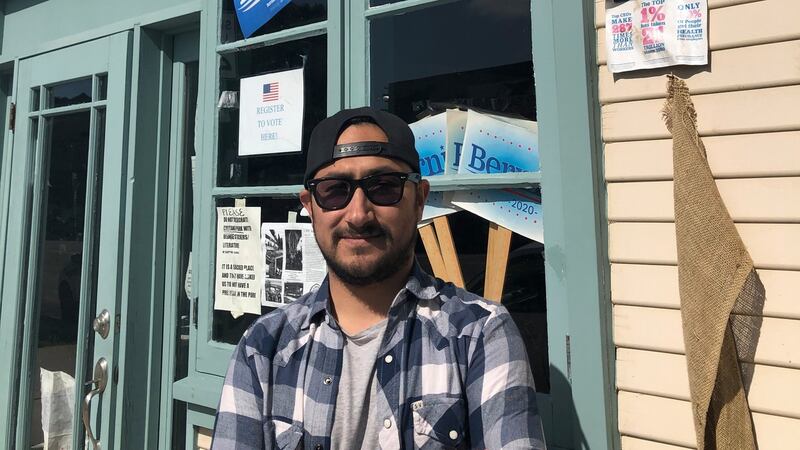The brightly-coloured paintwork is unmistakable, standing out from the drab, grey streets in this downtown neighbourhood of San Diego.
"Unidos con Bernie" reads the sign over the door of the Bernie Sanders campaign headquarters – one of several he has opened across the state.
The Vermont senator is hoping that a strong ground campaign in districts such as this can help propel him to victory next week, when Californians go to the polls on Super Tuesday.
California, with its population of 40 million, has long been strategically important for presidential hopefuls. The state sends 416 pledged delegates to the Democratic National Convention in July, the most of any single state.
This year it has taken on extra significance. While the 2016 Californian primary took place in June, now it will be held on March 3rd.
In past years the primary race has often been a fait accompli by the time Californians cast their vote, but this year the west coast primary could shape the outcome of the Democratic race.
"A good performance in California delivers a huge advantage in terms of delegate counts going into the convention," says San Diego-based political strategist Jason Roe. "But it's also symbolic. This is the leading progressive state in the union, with one of the most diverse electorates. A strong showing here can really add momentum."
Candidates in the primary race have been campaigning in the state for months. Julián Castro, who is supporting Elizabeth Warren having dropped out of the race himself last year, visited San Diego last Saturday.
Pete Buttigieg, who has attracted big money from the west coast tech community since announcing his candidacy, flew directly to Sacramento after the New Hampshire primary on February 13th.
Joe Biden’s wife Jill is campaigning in the state this week as her husband hit the trail in South Carolina.
But it is Sanders, who secured a decisive victory in neighbouring Nevada last weekend, who is in pole position in California, according to multiple polls. A KQED poll this week put Sanders at 36 per cent among likely Democratic primary voters. Warren was at 18 per cent followed by former vice-president Biden at 10 per cent, and Buttigieg at 9 per cent.
The Sanders campaign has put California at the heart of its election strategy, investing more than $6 million (€5.5m) in advertising in the state, including more than $1 million in Spanish language advertising.
I feel like he is getting a second chance
This energetic ground campaign is on display at his San Diego campaign office in the city.
On this cool February morning dozens of volunteers have gathered to campaign and make phone calls on behalf of the 78-year-old senator. A sign outside the office reads “In need of Spanish-speaking volunteers”, an indication of the demographics of California’s second biggest city.
Just 30km from the Mexican border, the city has long been a destination for migrants from Mexico and central America. About one-third of the population of San Diego county is Hispanic.

Damian Roman (33) is one of several local residents who have come by the office to volunteer. He moved from Mexico with his parents when he was 11 and runs a business in the city. He and his family were undocumented for 13 years, but they are now US citizens.
Though he said he supported Sanders in 2016, this time around he is much more engaged in the campaign. “I feel like he is getting a second chance. Last time I didn’t volunteer or donate, but this time I feel he has a real chance,” he says as he heads out on his second canvass of the election cycle.
Roman said that while there is a tendency to associate Hispanic voters with immigration, that is not always the primary issue motivating the Latino vote.
“When my family was undocumented, yes, it was our main concern, but once we reached a certain threshold and became American citizens we became engaged with issues just like any other American. Healthcare for example. I come from a country where healthcare is free. It’s not a perfect system, but it’s better than here in the US.”
He notes that many members of his community lean Republican, undercutting a common assumption that all Latinos are Democratic voters. San Diegans elected a Republican mayor, for example, while the city is the site of a huge naval base that attracts a large number of military and ex-military families, many of whom vote Republican.
Nonetheless, while it is questionable how many Republican or Independent voters in California will choose Sanders if he becomes the Democratic Party’s nominee, the senator is making inroads into a powerful voter base as he tries to win the primary contest.
California has the highest percentage of Latino residents per state in the country. But the community is typically under-represented when it comes to voter participation. The midterm elections in 2018, however, saw a sharp increase in the Latino vote, in part reflecting the fact that more younger Latinos became eligible. More than 11.7 million Latinos voted in 2018 compared with 6.8 million in the midterm elections of 2014.
The Sanders campaign is banking on this voter bloc, a strategy it hopes to replicate in Texas, which has a similarly large Latino vote and also holds its primary on Tuesday.
A strong performance in the two largest and delegate-rich Super Tuesday states would help Sanders consolidate his early lead in the primary contest.
With more than one-third of delegates to be decided next week, the socialist senator may build up an insurmountable lead in the race to become the Democratic nominee.











